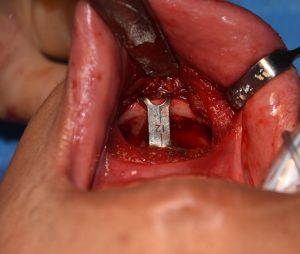Background: The sliding genioplasty is one of the most well known of all the facial bone osteotomies. It is a unique lower facial osteotomy because it has no functional impact on jaw movement. The chin is a pure aesthetic aspect of the lower jaw that is not responsible for any biomechanical load transfer. It is cut and moved for aesthetic purposes only and can alter the chin in three dimensions although the horizontal forward advancement is its most known movement historically.
The chin is a central projecting structure in which a horizontal advancement is moving a down fractured segment but into space so to speak. The fixation hardware used for most sliding genioplasties is placed centrally due to the midline access. As the chin bone is fixated centrally it is prone to asymmetries which can be due to differences in the length and angle of the osteotomy lines on each side as well as magnifications of any existing bone asymmetries.
When such asymmetries of the chin exist after the bone has been moved, there are two corrective approaches. The bone can be recut and repositioned or the position of the chin is maintained and the outer edges of the chin bone reshaped through either addition or subtraction. In most cases of sliding genioplasty asymmetries the latter is usually what would be effective.




It is not surprising that a few millimeters of tilt in the chin bone can become so apparent given that it creates the solitary central projection of the lower face.
Case Highlights:
1) The sliding genioplasty procedure is prone to asymmetries of the advanced chin segment.
2) More modest sliding geniopalsties asymmetries can be treated by a submental shave technique if reductive bone changes are the asymmetry correction.
3) A 3D CT scan is needed to make the proper assessment and measurements for how to make the reductive chin changes.
Dr. Barry Eppley
World-Renowned Plastic Surgeon






